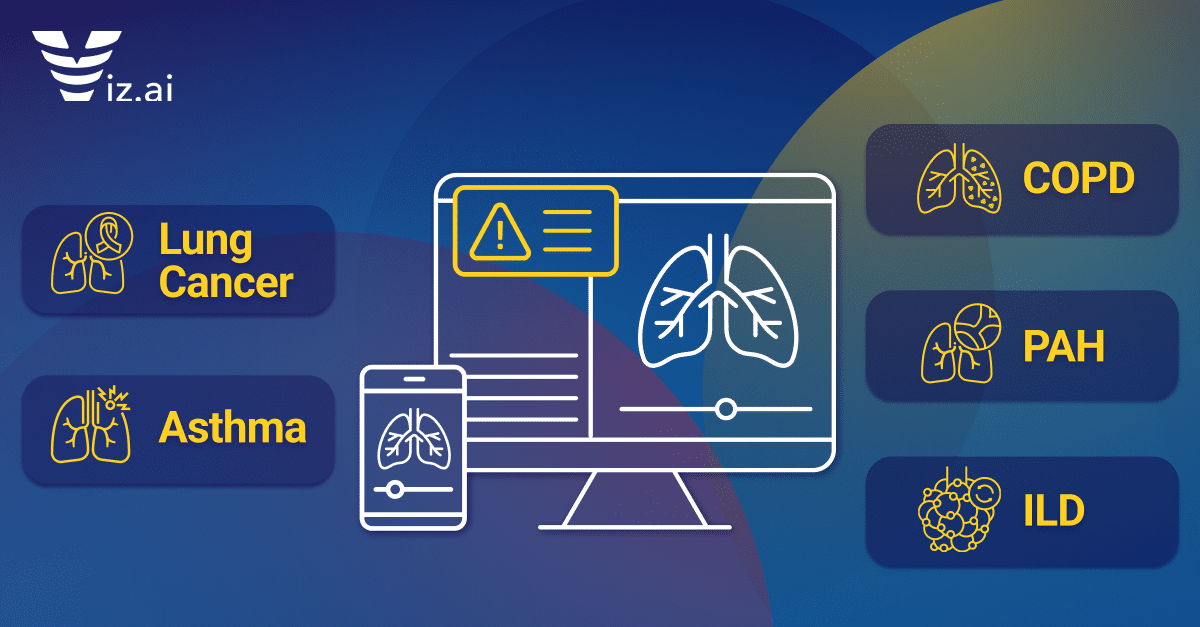
Sep 25, 2024
Nov 21, 2024
4 minutes
Written by Steven Dalvin, MD, Director of Life Science Innovation at Viz.ai

Lung diseases, including lung cancer, chronic obstructive pulmonary disease (COPD), asthma, pulmonary arterial hypertension (PAH), and interstitial lung disease (ILD), impact millions globally and rank among the top causes of morbidity and mortality1. Despite significant advances in treatment, many patients still face diagnostic delays, encounter challenges accessing specialty care, and have limited access to guideline-directed therapies.
At Viz.ai, we believe that AI-powered software has the potential to address these gaps. Data from our pulmonary embolism solution, Viz PE, recently demonstrated a 98% decrease in time to assessment and a 74% reduction in in-hospital mortality for pulmonary embolism2. We’ve also proven AI’s ability to get more patients diagnosed and to guideline-driven treatment. For example, in hypertrophic cardiomyopathy (HCM), Viz.ai has reduced time to diagnosis to 3 months vs. the standard of care of 3-5 years3. And in post-acute stroke, we’ve seen Viz.ai drive 8x as many patients to guideline-driven care vs. results without Viz4,5.
The impact that AI-powered care coordination software can have on patient care is becoming increasingly evident. Below, I’ve highlighted 3 ways in which we see technology continuing to drive better care in lung disease.
Diseases like lung cancer, pulmonary hypertension, and interstitial lung disease can present with subtle, non-specific findings that make diagnosis challenging. Other times, diseases are identified through incidental findings, like a lung nodule found on an unrelated imaging scan. In one study, only 36% of patients with lung nodules received any subsequent workup6. We can and must do better.

AI has vast potential to enhance diagnostic accuracy and detect or even predict disease; however, some of the most successful use cases we see tend to be centered around addressing existing gaps in care. A major theme we see across health systems today is administrative burden and lack of capacity, so solutions that act as triage tools, a second set of eyes, or automate manual processes can be some of the most impactful.
For example, an AI algorithm can help automatically identify a patient with a pulmonary nodule that was lost to follow-up or prompt a physician to take a closer look at subtle findings suggestive of ILD. These types of algorithms can be quite impactful when paired with thoughtful integration into provider workflows.
For chronic conditions like COPD and asthma, patients can present with exacerbations to outside emergency department or urgent care facilities, making it difficult to follow their care over time. This can lead to repeat exacerbations, hospital readmissions, and delays in therapy optimization. Notably, COPD has one of the highest 30-day readmission rates, comparable to conditions like pneumonia and heart failure.7
For complex diseases like lung cancer with increasingly sophisticated treatment protocols, many patients require care coordinated across radiology, pulmonology, oncology, and thoracic surgery. Without a well-organized approach, coordination can take significant time, contributing to delayed treatment initiation or, worse, suboptimal treatment.
Digital care coordination tools can help bridge some of these gaps by creating virtual “hubs” that flag high-risk patients, pull together information from disparate sources, summarize the information most relevant to a specific provider (e.g., a pulmonologist or oncologist), and enable cross-specialty HIPAA-compliant communication. When specialists have limited capacity and a mere 15 minutes per patient, AI-powered tools that help generate a quick and comprehensive understanding of a patient since their last visit and streamline next steps can be invaluable. EHR systems are not designed for this coordination, but as a system of transaction tracking for billing and audit trails.

Given AI’s vast potential at the point of care, it’s no surprise that three in five health systems are integrating AI into care delivery8, and 88% of healthcare leaders are already reporting significant improvements, including faster diagnoses, better care coordination, and more efficient workflows.9

Advances in precision medicine have ushered in new, targeted therapies for diseases like non-small cell lung cancer (NSCLC) that have led to remarkable improvements in outcomes but also introduce additional complexity to care delivery. While specialized thoracic oncologists may be able to focus their time and attention towards digesting the latest evidence in lung cancer, up to 80% of patients are treated by community oncologists who treat a wide variety of cancer types.10 For community oncologists, keeping up with rapidly advancing guidelines and evidence for lung, breast, prostate, GI, and hematologic cancers, among others, can be daunting.
Building on the concept of virtual “hubs” that help highlight high-risk patients and summarize relevant information, AI can play a crucial role in ensuring patient-specific, contextualized information about the latest guidelines and evidence-based practices are delivered to providers who need it. For instance, AI could review a patient’s medical record and cross-reference it with NCCN guidelines to surface appropriate treatment options or even relevant clinical trials.

AI-powered digital care coordination has the potential to transform lung disease management and more. By facilitating early detection, improving care continuity, and enabling personalized treatments, these tools can unlock a future where patients receive more timely, comprehensive care. For clinicians, AI can reduce the burden of information overload, bringing critical insights to the surface and enhancing the ability to make well-informed decisions.

We’re excited to continue building out this future together and look forward to reshaping patient care to improve outcomes, and ultimately, save lives.
